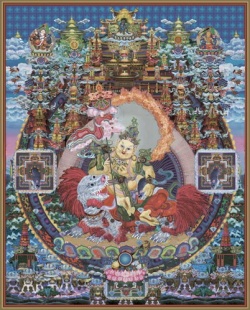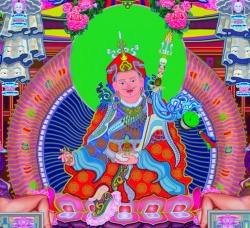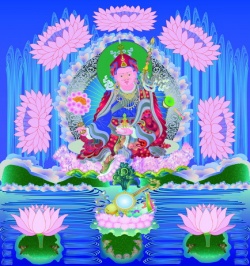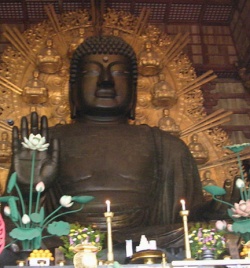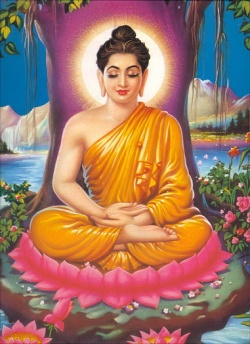Introduction to the Buddhist Path
INTRODUCTION TO THE BUDDHIST PATH
But without the practice of the perfection of wisdom, The obstructions will not come to an end. (Verse 41b) Thus, to eliminate all obstructions
To liberation and omniscience,
The practitioner should continually cultivate
The perfection of wisdom with skillful means.” (Verse 42) Atisha’s Lamp for the Path to Enlightenment
THE FIVE PATHS
In Buddhism there are Five Paths that outline where a person finds him/herself on the Stages of the Path to Nirvana or Enlightenment. The five paths include: Path of Accumulation (Tsog lam)
Path of Preparation (Jor lam)
Path of Seeing (Tong lam)
Path of Meditation (Gom lam)
Path of No More Learning (Me lhop lam)
In relation to the five paths, it is helpful to know that there are three vehicles (yanas) that each describe the five paths, yet offer distinct realizations of the overall path. The three vehicles (yanas) include:
1. Sravakayana (Hearer vehicle)
2. Pratekyabuddhayana (Solitary Realizer Vehicle)
3. Mahayana or Boddhisattvayana (Greater Vehicle)
As each of the three vehicles outlines the five paths in specific ways, in total there actually are fifteen paths. The first two vehicles (Sravakayana and Paratekyabuddhayana) relate to the Hinayana tradition and the final relates to the Mahayana tradition (as its name states). The Path of Accumulation
For any of the three vehicles, the beginning of the practice is called the Path of Accumulation. This means that a person possesses a strong desire to overcome suffering, either their own or being willing to help others overcome their suffering. Renunciation of the worldly life is a second important aspect of this stage of the path.
When someone possesses these two motivations, it shows a person is on the Path of Accumulation. Each of these two motivations can be seen to relate to whether a person belongs to the two vehicles of the Hinayana or Mahayana. Regarding the motivation to overcome suffering, if someone desires to overcome their own individual suffering they are situated in the Hinayana Path of Accumulation. If someone wishes to help all living beings this determines they are on the Mahayana Path of Accumulation. In relation to the motivation for renunciation, when a person renounces a worldly life for their personal benefit, this would be Hinayana, and if a person renounces a worldly life for the benefit of all living beings this would be Mahayana. To identify oneself as being on the Mahayana Path of Accumulation requires that a person possess a Bodhicitta mind (loving-kindness and compassion for all living beings).
The Path of Preparation
According to the Buddhist point of view, suffering is due to a lack of understanding of reality (ignorance). A person is identified as being on the Path of Preparation when they undertake meditation and analysis on the nature of reality primarily through reasoning. The person in the Path of Preparation normally meditates for a limited duration and without complete clarity. Although a person will have an understanding of the concept of the selflessness of the self or of emptiness (sunyata), and be aware that this is necessary to overcome suffering, they will not have direct perception of the selflessness of the self or of emptiness. A person in the Path of Preparation is working towards gaining this direct perception of selflessness of the self or of emptiness (sunyata).
The [[Path of[Seeing]]
When a person is on the Path of Seeing, s/he will practice profound concentration meditation on the nature of reality and as a result, their direct perception is able to realize the selflessness of the self or emptiness (sunyata). When this occurs this indicates that he or she is on the Path of Seeing. When one has completed the Path of Seeing, he or she will be freed from Samsara (the cycle of suffering). This means they have achieved the realization of selflessness or the realization of the interdependent origination of emptiness, and experience no more negative emotions because there is an understanding of the nature of reality. It is important to note that from the point of view of the first two vehicles (belonging to Hinayana), ignorance is the root of suffering and there are two forms of ignorance:
1. the intellectual grasping of the self, and
2. the innate grasping of the self.
The intellectual grasping of the self would include factors relating for example to culture or the environment that cause misunderstandings or false perceptions. Innate grasping of the self is not related to culture, environment or external influences, but arise solely from deep, internal habituation, which all sentient beings possess. An example to help explain the difference in purifying these two forms of ignorance would be to compare it to washing your clothes. Cleaning out coarse dirt from your clothing is like purifying the intellectual grasping of the self and cleaning subtle stains are comparable to purifying the innate grasping of the self. Although, after the Path of Seeing, the intellectual grasping of the self (coarse dirt) has been purified, the innate grasping of the self (subtle stains) will be reduced, yet remains. This is why the Path of Meditation is important to purify ignorance relating to the innate grasping of the self to achieve the Path of No More Learning.
From the Mahayana point of view, the intellectual and innate grasping of the self also cause suffering, but are understood to be coarse level of ignorance. In Mahayana, the root of suffering is seen to be the belief that the self and other phenomena inherently exist, which is a more subtle form of ignorance. Within the Path of Seeing, an understanding of emptiness is gained which reduces the idea that the self or other phenomena exist independently, and the coarse level of delusions are cleansed. Within Mahayana, it is asserted that wisdom is insufficient to purify the subtle imprints of delusion, which require the additional element of Bodhi mind together with various degrees of wisdom to reach levels much more profound than achieved in the Path of Seeing.
The Path of Meditation
It is only after a person has completed the Path of Seeing and purified the intellectual grasping of the self and perceives the interdependent origination of emptiness that one can begin to purify the innate forms of ignorance (innate grasping of the self and subtle imprints of delusion). For the two Hinayana vehicles, the direct perception of the selflessness of the self will foster increased wisdom with a motivation to overcome suffering, which when practiced repeatedly will reduce the innate grasping of the self until it is completely purified. This is the Path of Meditation, after which they have fully overcome suffering and reach Nirvana and enter the Path of No More Learning.
For the Mahayana path, the Path of Meditation is divided into ten steps to purify the innate grasping of the self, ignorance, and imprints of delusion. In the Path of Meditation, the practitioner is cultivating wisdom combined with Bodhicitta mind, which becomes increasingly powerful as one proceeds along the ten steps. It is possible to achieve ten different levels of wisdom, which are the antidote to ten levels of ignorance. It is as though there are shadows in a room and when each of ten lights is turned on, the room becomes brighter and brighter. After the ten lights are all turned on, no more darkness remains. At this time, a person has purified all subtle imprints of delusion and has arrived at the Path of No More Learning. At this point, you may be asking where Tantra fits in this process. The tenth level of wisdom can not be achieved through an understanding of emptiness and Bodhicitta alone. The tenth level of ignorance requires the most subtle, pure consciousness to penetrate sufficiently to purify the most subtle imprints of delusion. It is Tantric practice which offers access to the most subtle, pure consciousness.
The Path of No More Learning
The Path of No More Learning is when a person has purified all ignorance, delusions, and imprints of delusions. A person in this path is all knowing. This stage is called Enlightenment.
